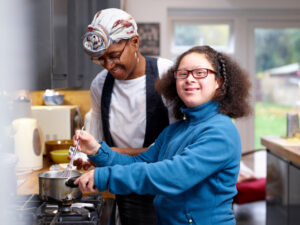 It’s common for people to use the phrases Applied Behavior Analysis (ABA) and Discrete Trial Training interchangeably. Yet, those of us who work in ABA know that while there is a relationship between the two, they are not the same thing.
It’s common for people to use the phrases Applied Behavior Analysis (ABA) and Discrete Trial Training interchangeably. Yet, those of us who work in ABA know that while there is a relationship between the two, they are not the same thing.
For example, you may say school and classroom interchangeably in conversation, yet most recognize that there is a clear difference. The school is the main structure, and the classroom is a segment of the school. Make sense?
Discrete Trial Training, often called DTT, is just one piece that falls under the broader picture of Applied Behavior Analysis.
Let’s take a closer look.
ABA is an evidence-based approach to understand and improve human behavior – including what behavior looks like, how it changes over time, and how to teach and implement new skills to modify behavior. Think of ABA as a larger umbrella that encompasses multiple components and practices underneath it.
The following practices live under this ABA umbrella:
Now that we’ve broadly explained Applied Behavior Analysis and the practices that fall under it, let’s navigate through the finer details around Discrete Trial Training.
DTT is used to teach new skills or concepts to individuals with disabilities, including those with Autism Spectrum Disorder. It involves breaking down behaviors or skills into chunkable pieces, or increments, and teaching the smaller steps one at a time in a repetitive and structured manner as a student works toward mastery and putting the steps together.
During DTT, an individual’s progress is constantly monitored so that adjustments can be made throughout the process.
To illustrate a possible task analysis, let’s use a box of macaroni and cheese as an example.
Skill: Cooking macaroni and cheese to completion.
Through DTT, which uses the principles of ABA, you would teach and repeat each individual sub-skill until it’s mastered. As students or clients teach/master the 1st Step, you will then use it to build up to the 2nd Step. Once those first 2 Steps are mastered, you would add in the 3rd Step until you reach completion (or a full bowl of mac n’ cheese, in this case).
A heavily researched technique, DTT is frequently used in school and therapy-based settings and has been proven effective in teaching communication skills, social interaction, adaptive and academic skills.
At TeachTown, our suite of special education solutions is based on research and the principles of Applied Behavior Analysis, with DTT woven throughout, including our technology-based teacher-led and student-led sessions.
If you’re interested in learning more about our K-12 standards-based, adapted core curriculum, enCORE, and our supporting interventions, schedule a consultation with a member of our team.
Contributor Bio
